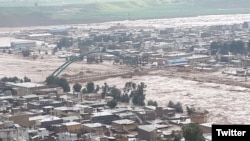Heavy rains in the past two days have completely overwhelmed several towns in the mountainous Lorestan province, where forced evacuations were ordered and people in many cases had to flee to nearby mountains to escape unending torrent of floods.
The head of Iran’s Red Crescent Sarem Rezaee says Pol-e-Dokhtar, one of these towns, is still in super-crisis state and rescue workers are trying to bring it out of emergency conditions.
The head of Iran's emergency services said crews are doing their utmost to help residents and four helicopters have been sent to Lorestan to rescue injured people and distribute food. He added that 150 people who needed medical attention were flown to hospitals.
Some reports say that more than 55 people have died so far as a result of two weeks of floods.
The Islamic Revolution Guard Corps (IRGC) once again blamed the civilian government for its inability to deal with the crisis. The commander of IRGC ground forces Mohammad Pakpoor said "there is no management" in the rescue and aid operations in Pol-e-Dokhtar and "no government official would dare" to show up in the area because "people are in a rebellious mood".
He insisted that "people are in a sorry state and conditions are bad".
Monday afternoon all communication and road connectivity with Pol-e-Dokhtar was lost, and Lorestan’s governor said that if extraordinary efforts are not made to send rescue workers and aid to the town “we will witness a great human tragedy”.
In a video taken mid-day Monday, a resident says that two-thirds of the city is under several feet of water”. The images from Monday might not tell the real extent of the crisis, which worsened later in the day.
Dozens of elite rescue workers have been sent to Pol-e-Dokhtar, with a population of just under 25,000, but there is no information yet about possible casualties.
All rivers in Lorestan have breached their banks and have turned into channels for unprecedented floods. The Marook dam in the area has been swamped by excess water, which has surpassed the top, but there is no information about the destruction caused by this incident.
It was reported on Monday that water levels in Khorramabad, the capital of Lorestan had reached 3 meters, or more than nine feet.
Water pouring over Marook Dam in Lorestan
Mahmoud Sadeghi, a member of parliament addressed Iran’s vice president in a tweet saying, “Mr. Jahangiri please come to the rescue of Lorestan province. Connection has been lost with a few towns and cities. Defenseless people are besieged by floods. All officials who are contacted say they cannot do anything”.
Another province in the grips of flood emergency is oil-producing Khuzestan. Midnight Monday it was reported that more than fifty villages have been evacuated.
Two major dams in the province are completely full and all emergency hatches are open to relieve excess water behind Karkheh and Dez. Residents on the path of the water outflow have been warned to stay away from rivers.
On Tuesday, an emergency situation was declared in the city of Shush (or ancient Shusha). Thirty villages in the area were evacuated, in addition to was announced earlier for Khuzestan.
Multiple landslides have blocked small and major roads, as well as railroads in western and southwestern Iran. The rail link between the capital Tehran and Ahvaz, the capital of Khuzestan was severed on Monday.
Roads have also been blocked in northern parts of the country. The highway from Rasht, on the Caspian Sea and Qazvin to the south has been cut.
The Alborz mountain range in the north is covered with heavy snow that is melting fast with the rains and adding to water volume in rivers.
Heavy rains continue from midnight Monday in almost half the country, from north to center to the west and southwest.



